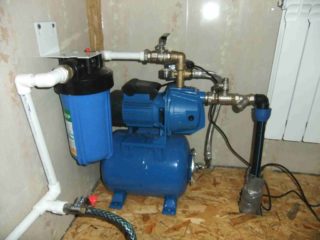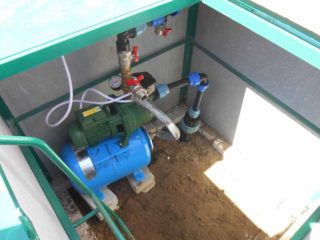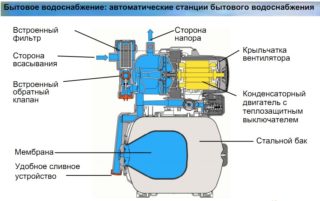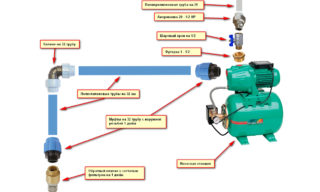Pumping stations are installations with a ground pump that draws water from borehole sources and wells in private households and dachas by creating a vacuum area. They differ from submersible pumps in that they keep constant pressure in the water supply network. For round-the-clock uninterrupted operation of the station, it is necessary to correctly connect it. If you act consistently, you can do it yourself, without calling professionals.
Selection of a place and installation scheme

Before connecting the pumping station to the well and home water supply with your own hands, you need to determine the place where the equipment will be located:
- basement or subfloor;
- caisson - a pit with insulation and waterproofing, located below the level of freezing of the earth;
- shelf in the well.
The installation scheme depends on whether the ejector is mounted in the apparatus, or it is remote and will be lowered into the well. In the first case, the arrangement of the caisson will be required, since such a station is capable of raising water only from a nine-meter depth. Devices with a remote ejector element are mounted if the water intake depth is large - up to 50 m. Then the ejector is placed inside the well string. Two flexible hoses from the pumping device are connected to it - pressure and suction.
Through the first, the liquid enters the ejector, forming a vacuum zone in the suction compartment, along the second, the water flow from the well shaft rises upward. A distinctive feature of such devices is a low noise level and the possibility of installation at a distance from the well.
It is also required to install the device in the pit at the summer cottage so that it is not stolen during the absence of the owners. You can put it on a shelf in the well, but for safety you need a sturdy metal cover that will be closed with a strong lock.
It is most reliable to install a water supply station in the basement, underground or storage room of a private house. The main drawback is the hum from her work. To reduce the sound level, the installation is placed on a thick rubber gasket, but absolute sound insulation cannot be achieved.

When arranging the station, you also need to consider:
- no contact between the equipment body and walls;
- free access for repair work and routine inspections;
- ensuring non-stop water supply from the source.
If the water supply system is used year-round, it is necessary to consider frost protection. To do this, a straight ditch is dug from the well or the caisson to the foundation of the building, followed by laying pipes into it.
It is required to lay the pipeline below the freezing point of the soil. In addition, when arranging the trench, the slope towards the intake of liquid is taken into account to drain the water remaining in the line for the period of conservation. In the case of a close location of underground sources, pipes are mounted above their critical level. The main line must be insulated or equipped with a heating cable.
The electric motor of the pumping station is quite powerful, so it is worthwhile to lay a separate line for it supplying electricity, equip grounding, and also install a voltage stabilizer.
The main elements of the pumping station

Thanks to the operation of the installation, the water supply circuit can be mounted with the maximum number of branches, which will greatly facilitate the connection of household appliances to it.
Structurally, the following units can be included in the package:
- centrifugal pump;
- hydraulic tank;
- water intake system with a non-return valve;
- Electrical engine;
- pressure gauge;
- pressure switch.
In modern installations, the last two elements are included in the automation unit. This expands the capabilities of the station. In addition to switching electrical circuits, in response to an increase and decrease in pressure, the automatic unit automatically turns off the unit at the risk of dry running.
Connection to water intake and domestic mains

Do-it-yourself assembly and connection of a pumping station to a well and a water supply system is carried out in the following sequence:
- Installation of a water intake unit. To do this, connect a filter element made of metal mesh and a non-return valve to the outside of the well pipe, which is necessary for stable filling of the pipeline with water. Secure it with an external thread sleeve.
- Installation of a hydraulic tank and control unit using a union with five leads.
- Connecting the water dispensing points to the accumulator through the dispensing manifold.
When consumers are started, water begins to flow from the hydraulic accumulator and is consumed until the pressure drops to the minimum limit. Then the pump turns on, and the drive is refilled with water.
When assembling the installation elements located on the surface, it must be borne in mind that all connected devices are mounted using non-return valves or ball valves with an American valve. This is necessary for easy disconnection during repairs.
You should worry about the possibility of a spillway from the mainline in advance. To do this, a branch is made in the water supply network by installing a tee with a shut-off valve connected to it.
Launching and Verifying Installation Correctness

Test the device before using it. Before starting, the working part of the system is filled with liquid. You will need to unscrew the plug from the filler hole equipped at the top of the pump or use a special funnel. After filling the working compartment, the plug is installed in place.
Then the unit is connected to the mains for smooth start-up and pressure check and automatic unit. First, air will come out along with the liquid - air locks that have arisen when filling the pumping unit are removed.
A smooth jet without bubbles indicates the transition of the system to operating mode - you can use it.
After a maximum of three minutes after starting the installation, water should flow out of the outlet of the pressure line or open mixer. If it does not come in, the station turns off, liquid is added to the system, and then the unit is reconnected. After a successful launch, the technician is “run in”, and then the settings of the pressure switch and the hydraulic tank are adjusted.
After installing a pumping station on a water well with your own hands, the equipment must be regularly inspected. It is necessary to constantly monitor the condition of the coarse filter element and, if necessary, clean it. If the filter is dirty, it will reduce the performance of the station and water in jerks. In case of complete clogging of the filtration device, the pump will start to idle, as a result, the unit will turn off. The frequency of cleaning the filter depends on the amount of contaminants in the water.
With proper assembly and installation, the pumping station will function without interruption and maintain constant pressure in the autonomous water supply system.








